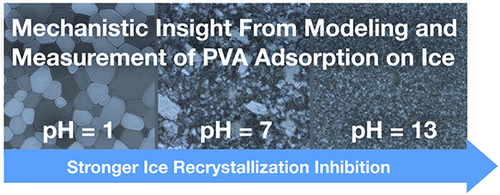当前位置:
X-MOL 学术
›
Biomacromolecules
›
论文详情
Our official English website, www.x-mol.net, welcomes your
feedback! (Note: you will need to create a separate account there.)
Understanding Poly(vinyl alcohol)-Mediated Ice Recrystallization Inhibition through Ice Adsorption Measurement and pH Effects
Biomacromolecules ( IF 5.5 ) Pub Date : 2017-12-21 00:00:00 , DOI: 10.1021/acs.biomac.7b01502 Aaron A. Burkey 1 , Christopher L. Riley 1 , Lyndsey K. Wang 1 , Taylor A. Hatridge 1 , Nathaniel A. Lynd 1
Biomacromolecules ( IF 5.5 ) Pub Date : 2017-12-21 00:00:00 , DOI: 10.1021/acs.biomac.7b01502 Aaron A. Burkey 1 , Christopher L. Riley 1 , Lyndsey K. Wang 1 , Taylor A. Hatridge 1 , Nathaniel A. Lynd 1
Affiliation

|
The development of improved cryopreservative materials is necessary to enable complete recovery of living cells and tissue after frozen storage. Remarkably, poly(vinyl alcohol) (PVA) displays some of the same cryoprotective properties as many antifreeze proteins found in cold tolerant organisms. In particular, PVA is very effective at halting the Ostwald ripening of ice, a process that mechanically damages cells and tissue. Despite the large practical importance of such a property, the mechanism by which PVA interacts with ice is poorly understood, hindering the development of improved cryoprotective materials. Herein, we quantitatively evaluated ice growth kinetics in the presence of PVA at different pH conditions and in the presence of a range of neutral salts. We demonstrated that pH, but not salt identity, alters the ability of PVA to halt ice grain coarsening. These observations are consistent with hydrogen-bonding playing a crucial role in PVA-mediated ice recrystallization inhibition. The evolution of the size distribution of ice crystals with annealing was consistent with incomplete surface coverage of ice with PVA. Binding assay measurements of dissolved fluorescently labeled PVA in an ice slurry showed that PVA interacts with ice through weak adsorption (<9%) to the ice crystal surface, which stands in contrast to fluorescently tagged type III antifreeze peptide, which binds strongly (ca. 64%) under the same conditions.
中文翻译:

通过冰吸附测量和pH值影响了解聚乙烯醇介导的冰重结晶抑制作用
为了使冷冻保存后的活细胞和组织完全恢复,必须开发改良的冷冻保存材料。值得注意的是,聚乙烯醇(PVA)具有与耐寒生物中发现的许多防冻蛋白相同的防冻性能。特别是,PVA在阻止冰的奥斯特瓦尔德熟化方面非常有效,该过程机械上破坏了细胞和组织。尽管这种性质在实践中具有很大的重要性,但人们对PVA与冰相互作用的机理了解甚少,这阻碍了改进防冻材料的开发。本文中,我们定量评估了在不同pH条件下在PVA存在下和一系列中性盐存在下冰的生长动力学。我们证明了pH值而不是盐的特性,改变了PVA阻止冰粒变粗的能力。这些观察结果与氢键在PVA介导的冰重结晶抑制中起关键作用是一致的。随着退火,冰晶尺寸分布的演变与PVA对冰的表面覆盖不完全相一致。在冰浆中溶解的荧光标记PVA的结合测定测量表明,PVA通过弱吸附(<9%)与冰相互作用,与冰晶表面相互作用,这与荧光标记的III型防冻肽形成了强烈的反差,后者具有很强的结合力(ca. 64%)。随着退火,冰晶尺寸分布的演变与PVA对冰的表面覆盖不完全相一致。在冰浆中溶解的荧光标记PVA的结合测定测量表明,PVA通过弱吸附(<9%)与冰相互作用,与冰晶表面相互作用,这与荧光标记的III型防冻肽形成了强烈的反差,后者具有很强的结合力(ca. 64%)。随着退火,冰晶尺寸分布的演变与PVA对冰的表面覆盖不完全相一致。在冰浆中溶解的荧光标记PVA的结合测定测量表明,PVA通过弱吸附(<9%)与冰相互作用,与冰晶表面相互作用,这与荧光标记的III型抗冻肽形成了鲜明的对比,后者牢固结合(ca. 64%)。
更新日期:2017-12-21
中文翻译:

通过冰吸附测量和pH值影响了解聚乙烯醇介导的冰重结晶抑制作用
为了使冷冻保存后的活细胞和组织完全恢复,必须开发改良的冷冻保存材料。值得注意的是,聚乙烯醇(PVA)具有与耐寒生物中发现的许多防冻蛋白相同的防冻性能。特别是,PVA在阻止冰的奥斯特瓦尔德熟化方面非常有效,该过程机械上破坏了细胞和组织。尽管这种性质在实践中具有很大的重要性,但人们对PVA与冰相互作用的机理了解甚少,这阻碍了改进防冻材料的开发。本文中,我们定量评估了在不同pH条件下在PVA存在下和一系列中性盐存在下冰的生长动力学。我们证明了pH值而不是盐的特性,改变了PVA阻止冰粒变粗的能力。这些观察结果与氢键在PVA介导的冰重结晶抑制中起关键作用是一致的。随着退火,冰晶尺寸分布的演变与PVA对冰的表面覆盖不完全相一致。在冰浆中溶解的荧光标记PVA的结合测定测量表明,PVA通过弱吸附(<9%)与冰相互作用,与冰晶表面相互作用,这与荧光标记的III型防冻肽形成了强烈的反差,后者具有很强的结合力(ca. 64%)。随着退火,冰晶尺寸分布的演变与PVA对冰的表面覆盖不完全相一致。在冰浆中溶解的荧光标记PVA的结合测定测量表明,PVA通过弱吸附(<9%)与冰相互作用,与冰晶表面相互作用,这与荧光标记的III型防冻肽形成了强烈的反差,后者具有很强的结合力(ca. 64%)。随着退火,冰晶尺寸分布的演变与PVA对冰的表面覆盖不完全相一致。在冰浆中溶解的荧光标记PVA的结合测定测量表明,PVA通过弱吸附(<9%)与冰相互作用,与冰晶表面相互作用,这与荧光标记的III型抗冻肽形成了鲜明的对比,后者牢固结合(ca. 64%)。









































 京公网安备 11010802027423号
京公网安备 11010802027423号